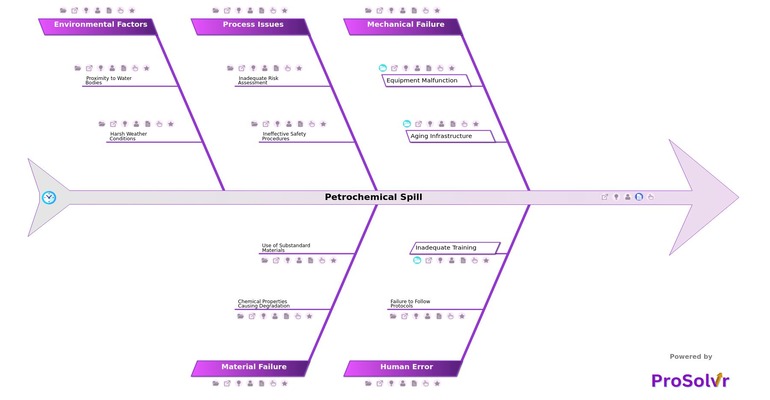Root Cause Analysis of Petrochemical Spill
In 2017, Haldia Petrochemicals Limited (HPL), located in Haldia, West Bengal, India, experienced a significant petrochemical spill. The incident occurred on January 31, 2017, when a pipeline carrying naphtha—a flammable hydrocarbon liquid used in petrochemical processes—ruptured, releasing a large quantity of naphtha into the surrounding environment. This led to contamination of the surrounding area, including soil and water bodies.
The naphtha release posed significant risks due to its toxic and flammable nature, raising concerns about long-term environmental damage and risks to local communities. The incident highlighted issues related to the maintenance and monitoring of aging infrastructure within the plant, disrupting HPL's operations temporarily and affecting production. This event underscored the urgent need for stricter safety and maintenance protocols in the petrochemical industry to prevent such occurrences in the future.
Using a Gen-AI-powered tool like ProSolvr for root cause analysis (RCA) can be crucial in preventing future incidents of a similar nature. This method helps break down complex issues into manageable categories, making it easier to identify the underlying causes of the spill. By ensuring that all potential causes are considered—not just the most obvious ones—the plant can develop corrective and preventive action plans. These plans may involve revising maintenance schedules, improving staff training, upgrading equipment, or enhancing monitoring systems.
Who can benefit from the Petrochemical Spill template?
Several groups can benefit from the insights gained through the root cause analysis (RCA) of the petrochemical spill at Haldia Petrochemicals:
- Plant Operations and Maintenance Teams
- Understanding equipment failures to improve maintenance practices.
- Enhancing operational procedures and safety protocols.
- Safety and Compliance Officers
- Strengthening safety measures and ensuring compliance with regulations.
- Developing better emergency response plans.
- Environmental Health and Safety (EHS) Professionals
- Identifying environmental risks and implementing effective mitigation strategies.
- Overseeing environmental remediation efforts post-incident.
- Engineering Teams
- Designing and implementing safer, more resilient systems and infrastructure.
- Addressing technical issues that may have contributed to the spill.
- Management and Leadership
- Making informed decisions regarding resource allocation for safety and maintenance.
- Fostering a culture of safety and continuous improvement within the organization.
- Training and Development Teams
- Revising and enhancing training programs based on identified gaps and deficiencies.
- Ensuring all personnel are adequately trained in updated safety procedures.
- Regulatory Authorities
- Assessing compliance with industry standards and implementing necessary policy changes.
- Using findings for broader industry safety improvements and regulations.
- Insurance and Risk Management Professionals
- Reassessing and adjusting risk profiles and insurance coverage based on the incident.
- Advising on risk mitigation strategies to prevent future spills.
- Emergency Response Teams
- Refining response strategies and improving coordination during spill incidents.
- Learning from real-world scenarios to better prepare for future emergencies.
- Local Community Representatives
- Understanding the risks associated with nearby petrochemical facilities.
- Engaging in discussions about safety improvements and community protection measures.
Why use Petrochemical Spill template?
A fishbone diagram, using Six Sigma principles, is particularly valuable in addressing petrochemical spills because it provides a structured, visual approach to identifying and categorizing the underlying causes of such incidents. By breaking down the problem into key categories, the fishbone template allows teams to systematically explore all potential contributing factors. This method ensures that not only the immediate cause but also deeper, less obvious issues—such as inadequate training, aging infrastructure, or ineffective safety procedures—are identified and addressed.
Ultimately, this comprehensive analysis helps in developing targeted solutions to prevent future spills, enhance safety protocols, and improve overall operational efficiency in petrochemical facilities. Use ProSolvr by smartQED for efficient problem-solving in your petrochemical plant.
Draft and create a template for problem analysis in ProSolvr by smartQED.








